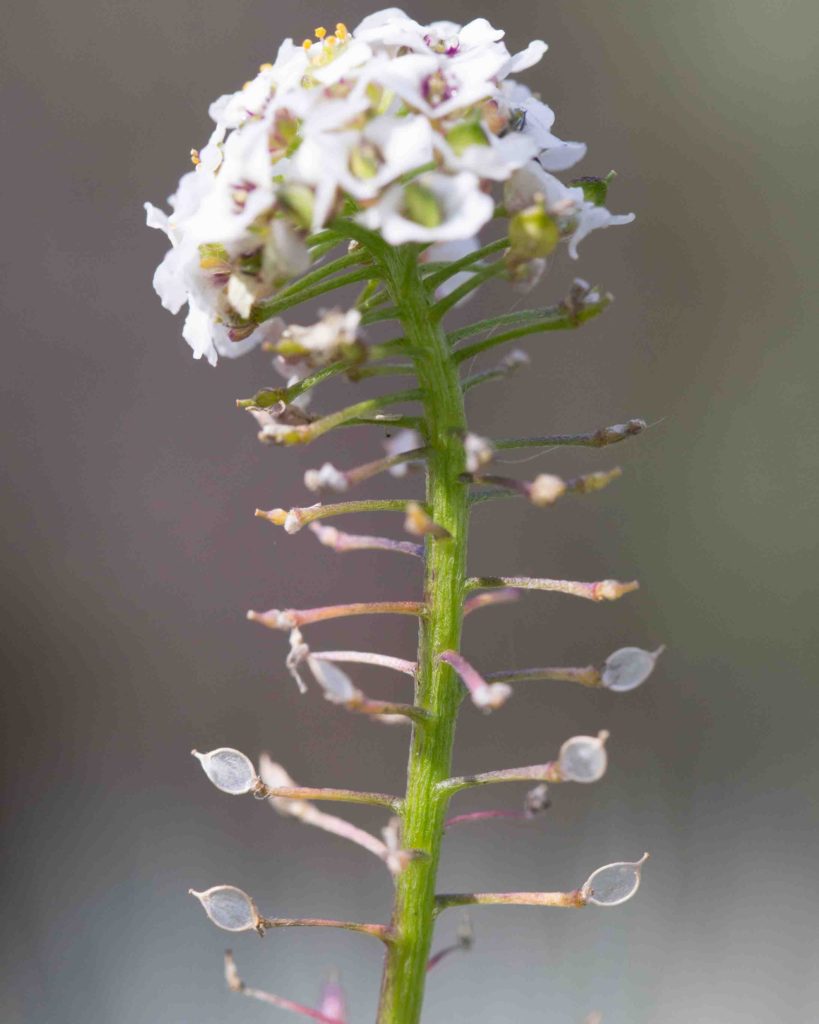Brassicaceae: Mustard Family — Miscellaneous
Members of the mustard family all have four petals, usually in a cross shape (hence Cruciferae; the old name for the family). With some groups, the flowers are quite similar, so it helps to pay close attention to the fruits. Fruits in the Mustard family are of two kinds, siliques and silicles. Siliques are at least twice as long as they are wide, while silicles are less elongated. Some siliques are more or less cylindric, others (as in the Wild Radish) are noticeably fatter at the base and taper towards the tip. Some silicles are erect and appressed to the stem, others grow outwards and curve upwards, or outwards and curve downwards.
European Sea Rocket – Cakile maritima
Blooms:
May–Nov
Plant Height:
< 80 cm
Flower Size:
Medium
Origin:
Europe
Invasive?
Yes – Limited
Habitat:
Beaches
Notes:
This is a common sight on beaches along the entire Pacific coast. It is more or less prostrate, with decumbent to erect stems and fleshy, pinnately-lobed leaves. Pink to lavender flowers are in more or less terminal clusters. The fruits (“rockets”) are distinctive, dry and light with two conspicuous “horns” at the joint. The fruits can survive for some days in the water as they float their way to another beach. Photos #1-2 by CJH.
Sweet Alyssum – Lobularia maritima
Blooms:
Mar–Oct
Plant Height:
5–25 cm
Flower Size:
Small cluster
Origin:
Europe
Invasive?
Yes – limited
Habitat:
Disturbed areas, fields
Notes:
This is a common, fragrant garden escape. It is immediately recognizable by its tight spherical clusters of diminutive white or pale purple flowers. Leaves are more or less linear. Fruits are round-elliptic, and the flat seeds are lens-shaped, opaque when mature.
Stock – Matthiola incana
Blooms:
Mar–June
Plant Height:
25–60 cm
Flower Size:
Medium
Origin:
European
Habitat:
Bluffs and sandy places along shore
Notes:
Stock has conspicuous violet to purple (occasionally white) flowers, borne on leafy stems. Biennial or perennial, it has tough, woody roots. Leaves are gray, densely hairy, oblong to linear and often clustered in dense rosettes. Fruits are long flattened cylindric siliques with noticeable constrictions between the individual seeds. A garden escape.
Wild Radish – Raphanus sativus
Blooms:
Mar–July
Plant Height:
40–130 cm
Flower Size:
Medium
Origin:
Europe
Invasive?
Yes – limited
Habitat:
Disturbed areas, fields
Notes:
Very common, this has flowers in a variety of colors, usually purple or pink but occasionally white or cream, mostly with fine veins. It commonly hybridizes with Jointed Charlock (Raphanus raphanistrum), and the results show great color variation. Upper leaves are simple, pointed or toothed, lower leaves are petioled and sometimes large and coarse. Maturing fruits have a distinctive long, conical tip. Fruits are edible with a mild radish flavor. Photo #3 by CJH.
Dobiepod – Tropidocarpum gracile
Blooms:
Mar–May
Plant Height:
10–50 cm
Flower Size:
Small
Origin:
Native
Habitat:
Grassy slopes
Notes:
This is the only native among the plants on this page. At first sight, it does not look like a member of the mustard family, but its 4-petaled, 6-stamened flowers and linear siliques show that it is. The stem is decumbent to erect, spreading and branching with rough hairs. Basal leaves are 10–15 cm long, divided into elongated lobes. Upper leaves are shorter and less divided.


















